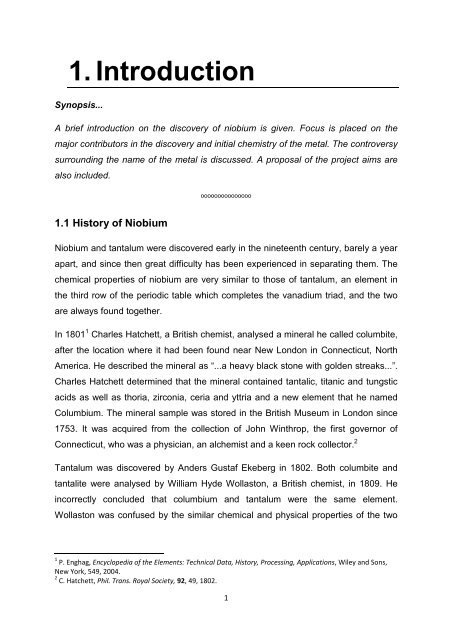A solution and solid state study of niobium complexes University of ...
A solution and solid state study of niobium complexes University of ...
A solution and solid state study of niobium complexes University of ...
You also want an ePaper? Increase the reach of your titles
YUMPU automatically turns print PDFs into web optimized ePapers that Google loves.
1. Introduction<br />
Synopsis...<br />
A brief introduction on the discovery <strong>of</strong> <strong>niobium</strong> is given. Focus is placed on the<br />
major contributors in the discovery <strong>and</strong> initial chemistry <strong>of</strong> the metal. The controversy<br />
surrounding the name <strong>of</strong> the metal is discussed. A proposal <strong>of</strong> the project aims are<br />
also included.<br />
1.1 History <strong>of</strong> Niobium<br />
ooooooooooooooo<br />
Niobium <strong>and</strong> tantalum were discovered early in the nineteenth century, barely a year<br />
apart, <strong>and</strong> since then great difficulty has been experienced in separating them. The<br />
chemical properties <strong>of</strong> <strong>niobium</strong> are very similar to those <strong>of</strong> tantalum, an element in<br />
the third row <strong>of</strong> the periodic table which completes the vanadium triad, <strong>and</strong> the two<br />
are always found together.<br />
In 1801 1 Charles Hatchett, a British chemist, analysed a mineral he called columbite,<br />
after the location where it had been found near New London in Connecticut, North<br />
America. He described the mineral as “...a heavy black stone with golden streaks...”.<br />
Charles Hatchett determined that the mineral contained tantalic, titanic <strong>and</strong> tungstic<br />
acids as well as thoria, zirconia, ceria <strong>and</strong> yttria <strong>and</strong> a new element that he named<br />
Columbium. The mineral sample was stored in the British Museum in London since<br />
1753. It was acquired from the collection <strong>of</strong> John Winthrop, the first governor <strong>of</strong><br />
Connecticut, who was a physician, an alchemist <strong>and</strong> a keen rock collector. 2<br />
Tantalum was discovered by Anders Gustaf Ekeberg in 1802. Both columbite <strong>and</strong><br />
tantalite were analysed by William Hyde Wollaston, a British chemist, in 1809. He<br />
incorrectly concluded that columbium <strong>and</strong> tantalum were the same element.<br />
Wollaston was confused by the similar chemical <strong>and</strong> physical properties <strong>of</strong> the two<br />
1 P. Enghag, Encyclopedia <strong>of</strong> the Elements: Technical Data, History, Processing, Applications, Wiley <strong>and</strong> Sons,<br />
New York, 549, 2004.<br />
2 C. Hatchett, Phil. Trans. Royal Society, 92, 49, 1802.<br />
1
















